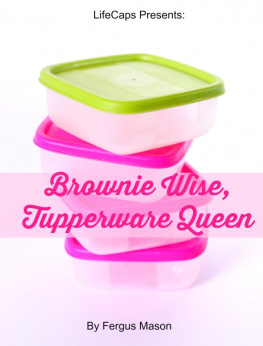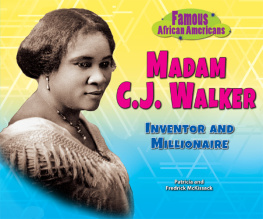2011 by Golgotha Press,Inc.
LifeCaps isan imprint of BookCaps Study Guides. With each book, alesser-known or sometimes forgotten life is recapped. We publish awide array of topics (from baseball and music to literature andphilosophy), so check our growing catalogue regularly( www.bookcaps.com ) to seeour newest books.
Introduction
When we think of inventors , there are a couple of stereotypes we all tend to fallback on. The most iconic perhaps is a mad scientist type withscrewdrivers and tape measures bristling from the pockets of hislab coat, and probably with his face blackened by the explosion ofhis latest failed prototype. More realistically, we might think ofa tech-savvy entrepreneur like Steve Jobs or James Dyson someonewith the vision to come up with an idea, and the time and resourcesto spend on turning it into reality.
What we probably dont imagine is asingle mom living on Long Islands North Shore, working asuccession of jobs to support herself and her three kids. In thosecircumstances, who has enough time to spare that they can see theneed for a new invention, come up with a design, get a prototypemade and tested, then get it into production and start marketingit?
Joy Manganodid. In fact she didnt do it just once shes done it over andover again. Mangano is one of the most prolific inventors in theworld today and she has an almost uncanny ability for coming upwith the right idea at the right time. Over and over again shestaken a familiar object and come up with a radically new twist, onethats grabbed the attention of millions of people and persuadedthem to part with hard cash for the pleasure of owning one of herinnovations. And unlike many inventors, shes always focused onthings that make life easier, less stressful or more pleasant forordinary people inventions that anyone can benefitfrom.
Mangano doesnt fit the popular idea of an inventor at all.Shes not a scientist or an engineer. She doesnt spend all hertime in a shed full of power tools making ingenious but alarminggadgets. These days shes as likely to be on Home Shopping Networkdemonstrating one of her many products as she is to be testing aprototype, because for more than a decade shes been the undoubtedstar of the retail channel. Millions of people have seen herenthusiastic performances, and been convinced to try out her latestidea as a result. Shes nowthe head of a multimillion-dollar business that shes created fromnothing, just by applying her formidable ingenuity. So how did alone parent from New York come to be such a powerhouse ofinnovation? What is Joy Manganos secret?
Well, thatsa good question. Mangano doesnt have a history of winning schoolscience fairs or building gadgets at home. She just seems to have atalent for spotting good ideas, and then turning them into reality.From the moment as a teenager when she realized her plans werepractical shes never hesitated to act when she believes shes comeup with something worth doing. It turns out that, usually, all ittakes is that initiative and a bit of determination and Manganohas plenty of both. Shes already developed more new products thanjust about anyone else and no doubt there are more to come. Letslook at her amazing history.
Chapter 1: Early Experiments
Joy Mangano was born in East Meadow, New York,i n 1956. Italian-Americans,the Manganos were great believers in initiative andentrepreneurship; her father ran a business that hired out schoolbuses and airport shuttles, and her mother helped out in theoffice. It was a family where energy and ambition were valued andJoy picked up on it from an early age. She also showed aninsatiable curiosity for electrics and mechanics anything to dowith how things worked. I was blowing up toasters in my parentshouse when I was little, she recalled in aninterview.
It wouldhave been understandable if Joys parents had some doubts abouttheir daughters technical experiments but instead, they encouragedher just as long as she didnt blow up the house. As she grewolder she started spending some of her spare time at her fathersbusiness, watching his mechanics work on buses and building up anuntrained but thorough understanding of how engineering works. Shestarted to try things out for herself; if she saw a device thatinterested her shed try to build a better one.
At the same time she was doing well at school, bothacademically and in sports. In fact , she did so well she graduated high school a year early.Somehow shed managed to be an honors student and high schoolathlete while also taking part in other hobbies and working astring of part-time jobs. It wasnt high school that planted theseeds of her future success, though; it was an idea she had whileworking at one of those jobs.
Agedsixteen, Joy was working in a local animal shelter in Huntington.Huntington is a fairly prosperous place and many families havepets. As a volunteer at the shelter Joy looked after those that hadstrayed or needed adoption, feeding them and helping with basichealth care. It wasnt long before she became depressingly familiarwith one of the major hazards to suburban pets traffic. Too manyof the shelters residents were dogs and cats whod survived anencounter with a car, often with horrific injuries, and naturallyJoy wondered how it might be possible to reduce this toll. Itwasnt long before she had an idea.
Domestic pets, like any other animal, are tempting targetsfor a whole range of parasites and one of the main health concernsfor a pet owner is keeping these away from their furry companion.Cats and dogs are particularly bothered by fleas, tiny, winglessinsects that puncture an animals skin with their sharp mouths anddrink their blood. Fleas arent usually a major health problem inthemselves but they can carry and transmit a range of diseases.In fact, the infamous Black Death, the plague that devastatedEurope in the 14 th century andkilled nearly half the population, was probably spread by infectedfleas. Thats less of a concern in suburban New York but fleas arestill a nuisance; their itchy bites are very irritating to pets,and theyre quite happy to bite the owners, too. Animal sheltersusually treat their residents with shampoos or skin drops but forowners that isnt always convenient, as anyone whos tried tomedicate a cat knows. Instead the most common option is a fleacollar. This is just a normal pet collar but the lining is treatedwith an insecticide thats harmless to the pet but lethal to fleas;it gradually spreads through the animals skin, poisoning any fleathat bites it.
Because mostpets that go outdoors wear flea collars, Joy realized this could bea way to make them more visible to drivers. The inner surface ofthe collar was an absorbent material that held the insecticide, butthe outer surface could be pretty much anything. If it could bemade from a reflective or fluorescent material it would meananimals could be seen in a cars headlights from much furtheraway.
Joy wasconvinced she was onto a good idea here, but now she had no ideawhat to do with it. She was a teenager; she had no businessknowledge, no idea how to go about securing a patent or having herdesign turned into prototypes that she could test. For a few weeksshe pondered on her inspiration, thinking of ways she could improveit as well as any possible option for making it a reality. In theend, though, she just didnt know what to do next and she decidedto leave it for now. After all she could come back to it later,when she knew how to turn it into a commercial product.












